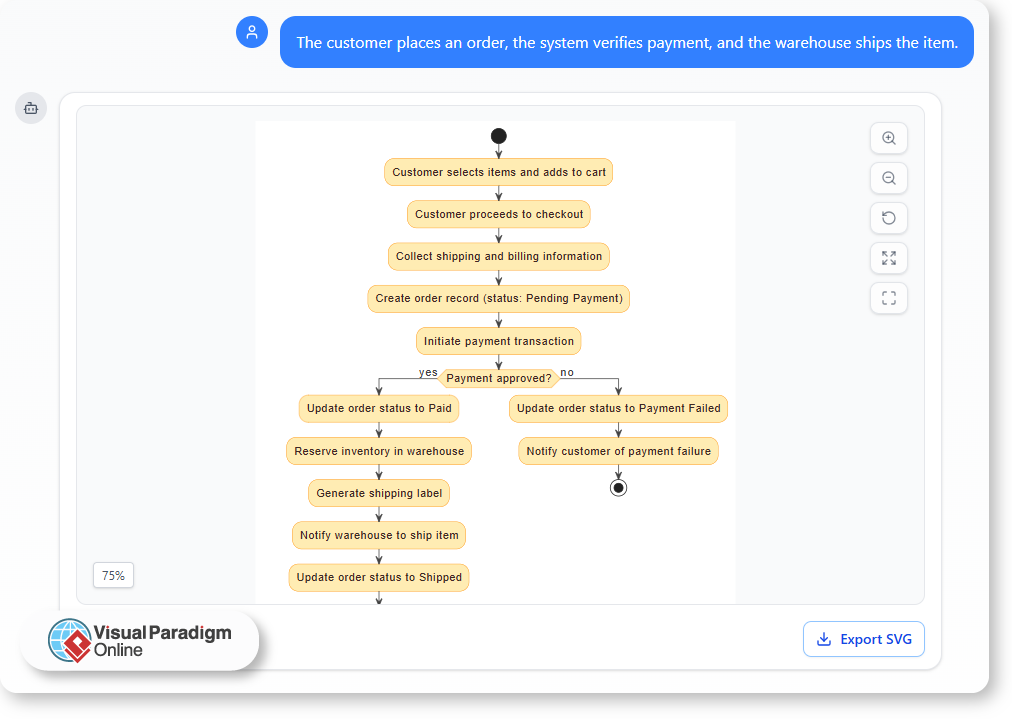Now Reading: From Ambiguous Requirements to Clear Visuals
-
01
From Ambiguous Requirements to Clear Visuals
From Ambiguous Requirements to Clear Visuals
How AI turns unclear ideas into structured, actionable diagrams
When project descriptions come in vague, inconsistent, or incomplete, design and development teams often spend more time interpreting ideas than building them. Ambiguity at the start of a project can ripple through every phase — from system design to communication and implementation. This is where AI-driven diagram generation steps in, helping you transform unclear requirements into meaningful visuals that everyone can understand.
The Challenge of Vague Requirements
In real-world projects, requirements rarely arrive as neat, well-defined statements. They are often expressed in emails, meeting notes, or user stories filled with assumptions. Phrases like “the system should manage orders” or “users can log in securely” may sound clear, but without context, they leave room for misinterpretation.
That ambiguity can cause:
- Conflicting understanding between business and technical teams
- Missing logic in process flows or system interactions
- Rework during implementation due to overlooked details
Traditional modeling methods rely heavily on manual analysis — requiring an expert to interpret each sentence before visualizing it. AI now provides a faster, more consistent way to bridge this gap.
How AI Bridges the Gap Between Text and Structure
AI-powered modeling assistants, such as the one in Visual Paradigm Online, understand natural language and translate it into visual structure. Instead of manually deciding which shapes, connectors, and relationships to create, you can describe your idea conversationally, and the tool visualizes it for you.
For example, if you type:
“The customer places an order, the system verifies payment, and the warehouse ships the item.”
The AI can interpret this and produce an activity diagram showing the sequence of actions — customer → system → warehouse — with corresponding flows. It captures logic that might otherwise remain implicit in text.

Beyond structure, the AI can also:
- Identify missing entities (e.g., “Who manages refunds?”)
- Suggest related interactions
- Adjust diagram types based on intent (use case, class, or component diagram)
Turning Complexity into Clarity
The real value of AI-generated diagrams lies in how they clarify relationships. What was once a loosely written paragraph can become a visual representation that:
- Defines actors, processes, and data interactions
- Reveals logical gaps or dependencies
- Provides a shared reference point for all stakeholders
Instead of arguing over wording, teams can point to a visual model and refine it together. Every adjustment — adding a missing actor, splitting an overloaded process — improves understanding.
Benefits Beyond Speed
While AI clearly accelerates modeling, the advantages extend deeper:
- Improved communication: Visuals make it easier to align technical and non-technical stakeholders.
- Reduced ambiguity: AI translates uncertain language into clear relationships.
- Early validation: Visual outputs highlight logical issues before implementation starts.
- Accessible design: Even non-experts can describe what they need and receive a professional diagram.
It turns a once-tedious task into an interactive dialogue between your ideas and the system.
From Rough Ideas to Structured Models
In a modern workflow, AI modeling tools act as intelligent assistants rather than replacements. You describe, the AI visualizes, and you refine. That feedback loop shortens the journey from vague ideas to structured, actionable models — keeping projects aligned from day one.
Whether you are building software architecture, mapping a business process, or outlining system behavior, AI helps you move from uncertainty to clarity.
With tools like Visual Paradigm’s AI Chatbot, even the roughest requirement can evolve into a diagram that speaks everyone’s language — visual, logical, and precise.
